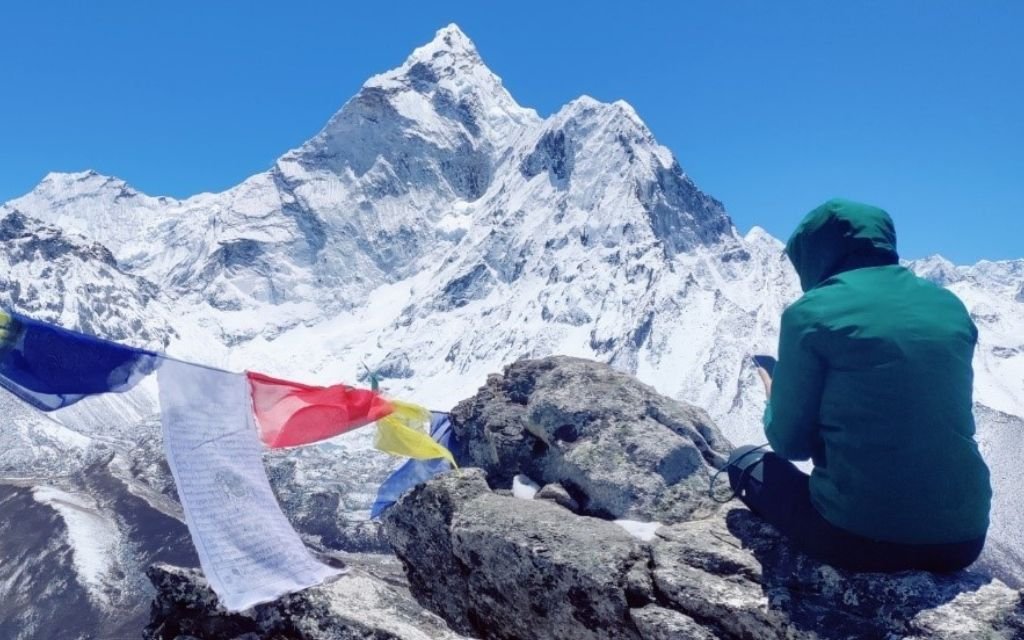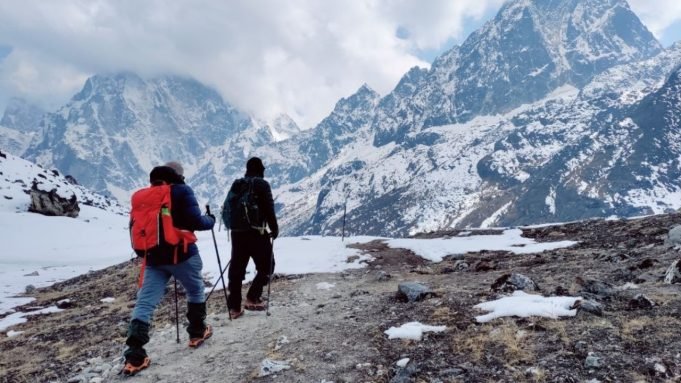The Everest region has captured the hearts of many adventure seekers and nature enthusiasts for generations with its unique landscapes, rich culture and breathtaking views of towering peaks. Nestled in the heart of the majestic Himalayas, the Everest region is a place where Nature meets Adventure.
The Everest Region is home to the world’s tallest mountain, Mount Everest. This region offers some of the most iconic trekking routes in Nepal. For example, the Everest base camp trek is on the bucket list for many adventure lovers as it leads you through dramatic landscapes, high mountain passes and the Sherpa villages.
For more daring and thrill-seeking adventurers there are more challenging routes like the Three Passes Trek and Island Peak climbing that offer you a taste of mountaineering adventure.
As you ascend through the unique and stunning landscapes of the Everest region, the thinning air becomes a significant concern. It is a well-known fact that as you ascend to high altitudes the oxygen level decreases and the air becomes thin which leads to difficulty in breathing.
This thinning air brings many challenges for trekkers and climbers in the Everest region. One of the most noticeable effects of reduced oxygen levels is shortness of breath which leads to fatigue and altitude sickness.
To safely conquer the iconic treks and to reduce the risk of altitude sickness, Acclimatization hikes in the Everest region are a crucial aspect of any trek in this region.
The Importance of Acclimatization
Acclimatization is a process of adjusting to the changes in the environment with respect to temperature, altitude, pressure and other environmental conditions. This process helps your body to adapt to the reduced oxygen levels at higher altitudes.
Acclimatization is not something that happens overnight; it requires time and patience. The primary goal of acclimatization is to prevent altitude-related illness and ensure a safe and enjoyable trek.
Here’s why acclimatization is absolutely necessary for the Everest Region treks:
To Prevent Altitude Sickness
As you ascend to higher altitudes, the atmospheric pressure decreases which leads to lower oxygen levels.
Altitude sickness can range from mild symptoms like headaches and nausea to more severe conditions like acute mountain sickness (AMS), high-altitude pulmonary edema (HAPE) and high-altitude cerebral edema (HACE).
Such severe conditions can occur when if your body is not adequately acclimatized. Always listen to your body and pay attention of how you feel and if you experience severe symptoms of altitude sickness, it is best to descend to lower altitudes to recover.
Acclimatization helps your body to adjust to lower oxygen levels and reduces the risk of life-threatening emergencies.
To Enhance your Physical Performance
Proper acclimatization not only keeps you safe but it also improves your physical performance. This process allows your muscles and cardiovascular system to adapt to the lower oxygen levels which improves your endurance, strength, and overall physical performance.
As your body adapts to the altitude, you will find it easier to breathe, walk, and carry your gear making your trek more enjoyable and less strenuous.
To Strengthen Your Mental Resilience
Acclimatization not only affects you physically, it also affects you mentally. As your body adapts to the altitude, your mental resilience increases and you become more capable of coping with the challenges of high-altitude trekking.
Popular Acclimatization Hikes in the Everest Region
Acclimatization hikes are a crucial part of the trekking experience in the Everest region. It is designed to help trekkers adjust to the thin air and low oxygen levels found at higher altitudes.
These hikes are strategically planned rest days, for trekkers to climb higher elevations during the day and then return to lower altitude base camp or hotels to sleep.
The main goal is to allow your body to adapt gradually to the reduced oxygen levels and reduce the risk of altitude sickness.
Some of the most popular acclimatization hikes in the Everest region include Namche Bazaar to Everest View Hotel, Khumjung & Khunde, Thame, Gokyo Ri, etc.
Namche Bazaar
Namche Bazaar is a charming mountain town in the Everest region situated at an altitude of 3,440 meters (11,286 feet). It is a thriving Sherpa town that can only be reached by hiking (on foot) or by helicopter.
Namche bazaar is a classic stopover point for famous trekking routes in the Everest region like the Everest base camp trek, Three Passes trek, Gokyo lakes trek, and other high-altitude destinations in the region.
When you arrive in Namche Bazaar you should already be well into the process of acclimatization.
Its strategic location serves as the much-needed acclimatization that helps trekkers adapt to the thinning air before ascending to higher altitudes. It is best to stay in Namche for at least two nights to let your body adjust to the higher altitude.
During your stay in Namche bazaar, it is advisable to go on short hikes to nearby higher points like Everest View Hotel, Khumjung Khunde, etc. These hikes help your body to slowly adjust to the thin air and low oxygen levels.
Staying hydrated is crucial for acclimatization. Rest, sleep and drink plenty of water to help your body recover and adjust to the altitude. Avoid caffeine, alcohol, and basically anything which can dehydrate you.
Everest View Hotel
Acclimatization at the Everest View Hotel is a common practice for trekkers. Everest View Hotel is located within Sagarmatha National Park at an elevation of around 3,880 meters (12,726 feet).
The hike to Everest View Hotel is followed by Namche Bazaar. The hike is not too tiring and offers breathtaking views along the way. You can enjoy spectacular views of Mount Everest, Lhotse and other nearby peaks.
Acclimatization at the Everest View Hotel is not only beneficial for acclimatization but also provides a memorable experience with breathtaking views of the world’s tallest peak.
The Everest View Hotel is not only an ideal spot for acclimatization but also a popular stop for Everest Base Camp helicopter tours. Here, you can enjoy a memorable experience with awe-inspiring views of the world’s tallest peak.
Just like in Namche Bazaar, it is essential to stay hydrated, rest well and allow your body to recover from the hiking and adjust to the altitude.
Khumjung and Khunde
Khumjung (3,780 meters) and Khunde (3,860 meters) are neighbouring Sherpa villages a little father up from Namche. These two towns are separated by stony fields, and rock walls and have stunning views on all sides. These villages are located at relatively high altitudes.
Khumjung is the largest village in the Khumbu located at the foot of the sacred peak Khumbila and a worthy place to visit is Khumjung School built by Sir Edmund Hillary’s Himalayan Trust in 1960.
Another must-visit is The Khunde Hospital built by Sir Edmund Hillary in 1966, located at the top of the village.
This route provides cultural insights, visits to monasteries, schools and the local way of life.
During your stay in Khumjung and Khunde, consider going on short hikes to even higher elevations. For example, you can hike to Khumjung Ri or Khunde Ri, which offer fantastic panoramic views of the surrounding peaks. This hike involves ascending and descending helping in acclimatization.
Thame Village
Thame is a picturesque Sherpa village in the Everest Region. it is located at an elevation of 3,820 meters.
It is convenient to walk to Thame on an acclimatization day when you reach Namche Bazaar during your Everest base camp trek.
Most trekkers arrive here after Namche Bazaar or other lower-altitude villages.
Thame offers stunning views and a rich cultural environment for acclimatization. You can visit the Thame Monastery which is the oldest in the Khumbu region of Nepal, and you can also enjoy the beauty of fabulous Himalayan landscapes.
The village offers stunning views of the Himalayan landscapes, including the towering peaks of Tengkangpoche and Kongde Ri.
Nangkartsang Peak

Acclimatization plays a crucial role in trekking to Everest Base Camp, allowing your body to adapt to higher altitudes and thinner air. Consequently, it’s highly recommended to incorporate a hike to Nangkartshang Peak, which stands at an elevation of 5,083 meters, as part of your Everest Region trekking itinerary.
Nangkartshang peak lies above the Sherpa village of Dingboche and it offers stunning views of Ama Dablam (6812 m), Makalu (8485 m), Lhotse (8516 m), Kantega (6782 m) and Cho Oyu (6160 m).
Nangkartshang peak is an easy ascent which may take up to 2 to 3 hours. Hiking to Nangkartshang peak above Dingboche is often ascended by many trekkers to acclimatize and kill the rest day.
Chhukung Ri
Chukkung Ri is a rocky mountain above the village of Chhukung in the Everest region. It is located at an elevation of 5,559 meters above sea level.
Chhukung Ri is a popular acclimatization point and trekking destination. Trekkers typically arrive Chhukung after spending some time in the lower altitude villages like Namche Bazar, Thame, Dingboche, etc.
It is often used as an acclimatization trip by people going on climb Island Peak summit (6,165 meters), especially if they haven’t been up to Everest Base Camp and Kala Patthar.
Chhukung Ri offer fantastic views of Imja Tse (6,165 meters), Ama Dablam (6812 meters), Makalu (8485 meters), and of Nuptse (7,861 meters) and Lhotse. You cannot see Mount Everest from here, and that’s probably the main reason why Chhukung Ri is a lot quieter than Kala Patthar and Gokyo Ri.
Gokyo Ri
Gokyo Ri is a stunning and prominent viewpoint located in the Gokyo Valley, within the Sagarmatha National Park. Gokyo Ri stands at an elevation of 5,430 meters (17,814 feet) above sea level.
After acclimatizing in Namche, the trek continues towards Gokyo Ri, passing through places like Dole and Machhermo.
By the Himalayan standards, the Gokyo Ri trek is considered a moderately demanding trek although you will be walking at a high altitude and will require sufficient acclimatization. So, if you’ve already hiked all the way to Gokyo, you should have no trouble reaching the summit of Gokyo Ri if you’ve followed correct acclimatization procedures.
The climb to Gokyo Ri provides breathtaking panoramic views of the Gokyo Lakes, Mount Everest (8,848 m), Lhotse (8,516 m), Cho Oyu (8,153 m) and other surrounding peaks. The hike is strenuous, but it helps your body adjust to higher altitudes.
Gokyo Lake V
Gokyo Lakes are oligotrophic lakes located at an altitude of 4700 meters to 5000 meters in the Gokyo Valley. It is made up of six lakes.
The lakes are named after Gokyo Ri Peak. Gokyo Lakes are the world’s highest freshwater lake system and have been known as a Ramsar site (a wetland site designated to be of international importance).
Gokyo lake is a wonderful trekking destination in the Everest region. Trekkers often follow a well-established route that starts in Lukla and passes through various villages like Namche Bazaar, Dole, Machhermo, and Gokyo. The journey typically includes acclimatization stops to allow trekkers to adjust to the increasing altitude.
The Gokyo Lake Trek offers a unique and less crowded alternative to the Everest Base Camp Trek while providing stunning views, cultural experiences, and the chance to explore the magnificent Gokyo Lakes and their surroundings
In conclusion, Acclimatization Hikes in the Everest region are not just an optional activity, it is a crucial component for a successful and safe trekking expedition. These hikes play an important role in allowing the human body to gradually adapt to the high-altitude conditions.
In the Everest region, altitude and oxygen levels entangles the human body and the natural environment.
Always prioritize your health and safety. If you experience severe altitude sickness symptoms, seek immediate medical attention and be prepared to descend to a lower elevation until you recover. Responsible trekking practices and proper acclimatization are essential for a successful and safe journey in this high-altitude terrain.
While it may take some time for your body to adapt, the beauty and majesty that surround you make every breath you take at higher altitudes truly worthwhile.
So, take a deep breath, embrace the challenge, and savour every moment of your Everest region adventure.















